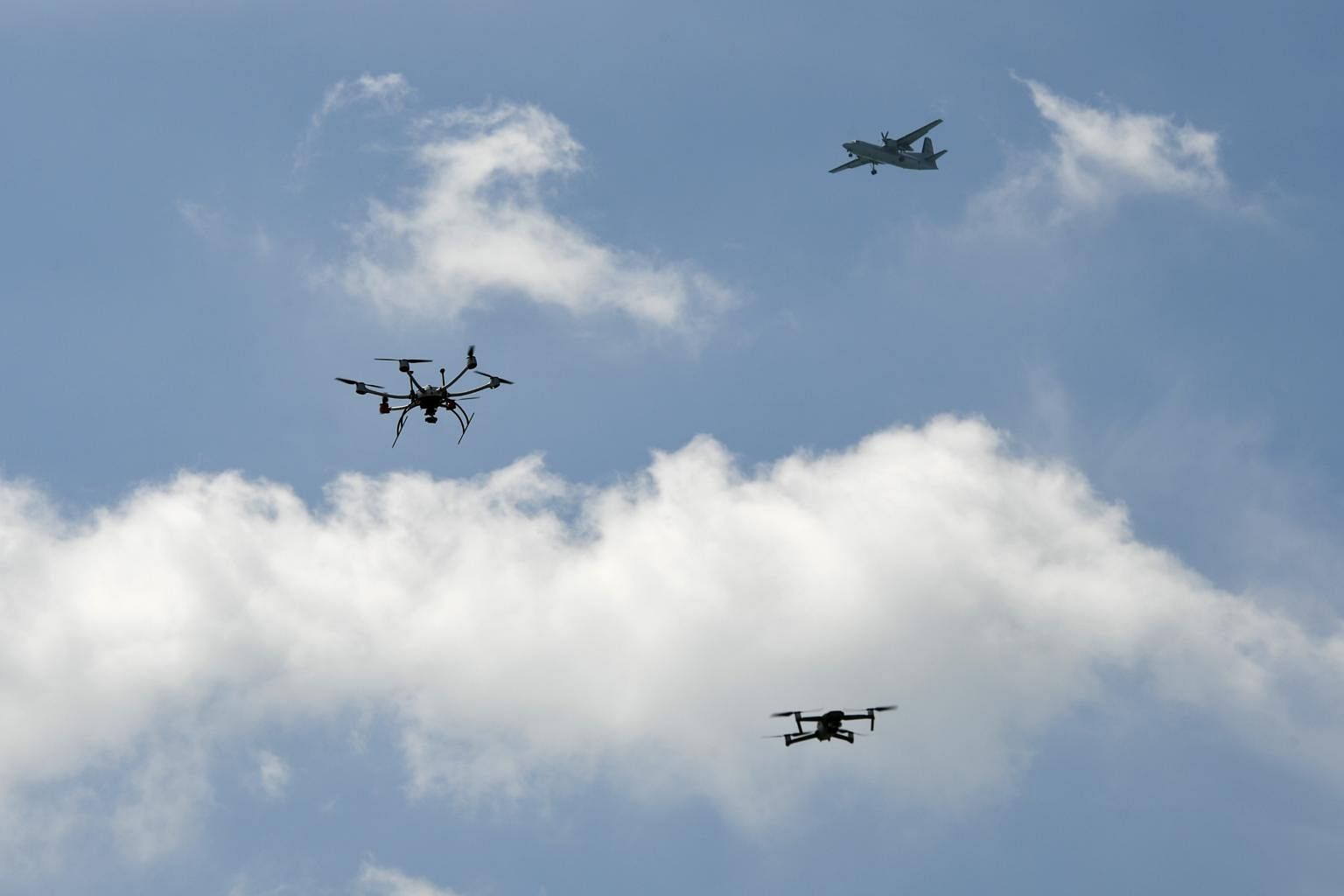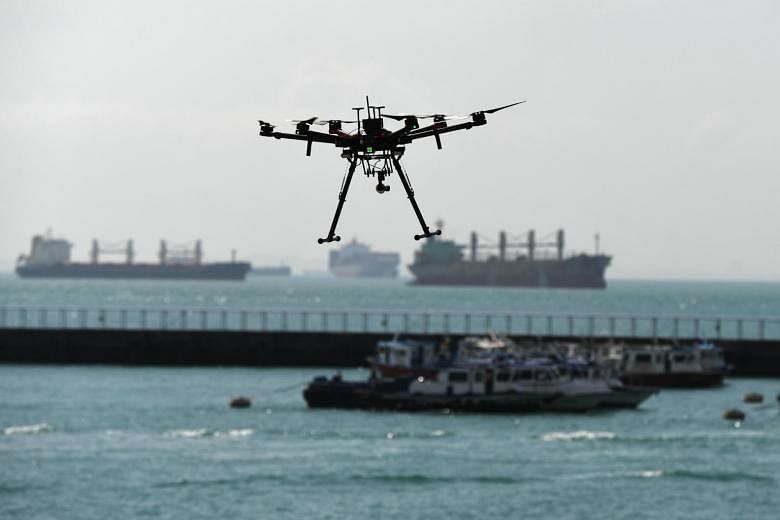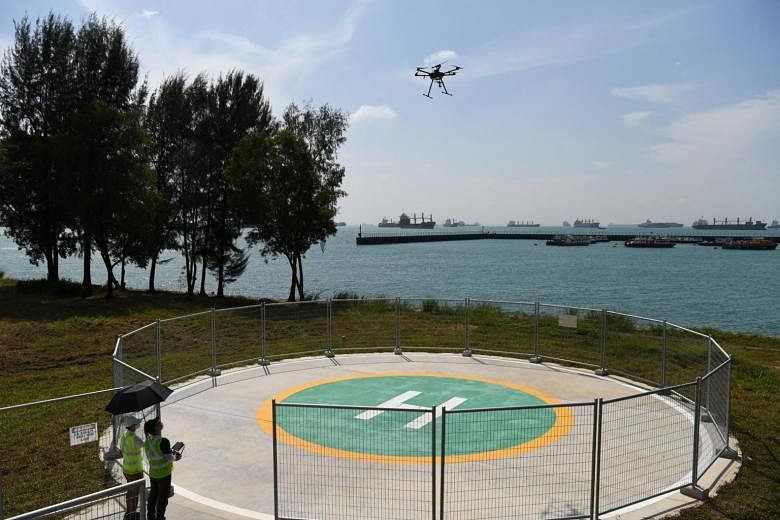SINGAPORE - The building blocks for an "air traffic control tower" for drones are in place after trials for the system were recently completed, a development the Government said would help efforts to find ways to better manage drone traffic safely on a large scale in Singapore.
Drone use on a mass scale could see them delivering parcels, inspecting buildings and ships and, possibly, even transporting people, not unlike scenes in science fiction.
A consortium led by Nova Systems, an Australia-headquartered technical consultancy and professional services firm, announced on Friday (March 12) that it had successfully completed trials for a system that can manage air traffic for unmanned aircraft systems (UAS), or aerial drones.
A demonstration of the system's capabilities was conducted earlier in the week, which was witnessed by officials and the media in Marina South.
The drone system, called a UAS traffic management system, arose from a call for proposals issued by the Ministry of Transport (MOT) and the Civil Aviation Authority of Singapore (CAAS) in 2017 to develop systems that allow for aerial drones to be used safely in Singapore's densely populated urban environment
The Nova consortium was awarded the project in 2018. Proposals from three other groups were also accepted by MOT and CAAS.
Each project received up to 50 per cent co-funding from the Government, with the amount capped at $1.5 million.
Mr Tan Kah Han, the senior director of CAAS' Unmanned Systems Group, told The Straits Times that the findings of the drone projects from the call for proposals would help "further refine our policies and enhance our regulatory framework".
He said that the outcome of Nova's drone system demonstration and the authority's work with other stakeholders "will aid CAAS' efforts to pursue more efficient ways to safely manage drone traffic at scale in Singapore".
"This is important, as Singapore's limited and congested airspace requires creative solutions to manage the risk posed by unmanned aircraft operations," Mr Tan added.
The Nova drone system is similar to a traditional flight management system for manned aircraft, which helps to assign and monitor flight routes in real time.
Such an "air traffic control tower" for drones helps operators, other parties and regulators keep track of where the unmanned aircraft are at any point in time, even if they cannot visually see the drones, which is an issue now.
In future, location data could be made available freely so anyone, for instance, can check where a drone delivering a parcel is.
Nova Systems' partners in the project include OneSky, a United States company that provides drone traffic management services, local telco M1 and German engineering firm Rohde and Schwarz, among others.
While no definite timeline has been given for future work on the drone system, Nova Systems and OneSky said that "in the coming years, the two companies will work closely together with the authorities and key industry partners to develop the technologies, regulatory frameworks, operating rules and performance standards to build this system".

The maritime sector is expected to be among the first to use the drone traffic management system. Mr Ryan Lee, managing director for Asia at Nova Systems, said that from a safety and regulatory standpoint, the maritime environment poses less risk for testing drone operations like deliveries.
"So, we can develop regulations, rules and standards required for maritime unmanned operations first and gain confidence and understanding before expanding to riskier environments like in the city where drones need to fly over people," said Mr Lee.
He added that from a business perspective, the maritime sector makes sense, as Singapore has one of the largest ports in the world, with many vessels transferring cargo and people.
"The deployment of drones could help reduce the cost of (transporting) people and goods, as well as make these deliveries a lot more efficient. In future, we could also reduce the carbon footprint of offshore deliveries (with drones)," said Mr Lee.
And, with the Covid-19 pandemic, drone deliveries to ships from land could also be done, instead of having people on boats do them - this reduces potential human exposure to the virus.
Mr Lee noted that overseas, Covid-19 test kits have been delivered with unmanned aircraft to crew on ships. In December last year, one such delivery was reportedly carried out to a vessel anchored near a port in Greece.
Nova's system also helps to ensure that the flight paths of drones do not cross, to prevent them from possibly crashing into one another.
The system can check if the machines are keeping to their designated routes, and issue alerts if they deviate from their routes due to, for instance, weather effects like rain and strong winds, or even birds attacking the unmanned aircraft.
If the system detects that a drone is in trouble or behaving abnormally, such as not following its flight path after a set amount of time, the system can alert other drones in the air to avoid the immediate area.
The system could also alert the authorities, which might then take down the rogue drone.

And if emergencies arise that require drones to be deployed, such as by public agencies, the system can prioritise flights and help to reschedule or reroute non-emergency flights.
Operators and the authorities can also monitor many more drones than is humanly possible now with the new air traffic system. It has been tested in simulations for up to 500 flights at a time.
Mr Lee said that the system is needed to manage a large number of drone operations at the same time because, "if left completely to human operators, this would be too intricate and large an undertaking, leaving room for potential human error".
This capability of the system is in anticipation of busier airspace in the future with more frequent drone flights and drones deployed en masse, such as for deliveries and air taxis ferrying people in the sky.
For example, German aviation start-up Volocopter said in December last year that it expects to launch air taxis in Singapore within the next three years.
Nova's drone system communicates with drones in the air through 4G and 5G mobile networks, with telco SIM cards inserted into them.
Currently, this has been tested to work at a range of up to 2km using 4G networks. But the range could be extended with 5G, and work is now being done in this area so that drones flying, for instance, farther out to sea can still be monitored from land.
If mobile communications fail at any time, the system can switch over to satellite communications, which is not otherwise used, as it is more costly, among other things.
Drone flights with the system have been tested in industrial, financial and residential areas, including at the Marina Bay Financial Centre, in Kallang, Orchard Boulevard and coastal areas near Kallang Riverside and Sentosa.
For residential areas, flights were tested in Robertson Quay and Lavender.
One potential speed bump to the commercialisation of the drone traffic management system is regulations.
Nova Systems and OneSky said that in Singapore, the implementation of such a system would require coordination between government agencies to establish a system of policies and regulations that address road safety, air traffic control, network capabilities, cyber security and national security.
The agencies would likely include the Land Transport Authority, CAAS, Infocomm Media Development Authority, the Ministry of Defence and the Ministry of Home Affairs.
Said Mr Lee: "Given the scale of the system and the multi-stakeholder collaboration required, it will take some time to roll out the relevant regulations to ensure utmost safety and security."
Still, he said that "we will continue working closely with the relevant regulators and stakeholders to develop the necessary rules and frameworks needed to realise the full potential of UAS tech".



